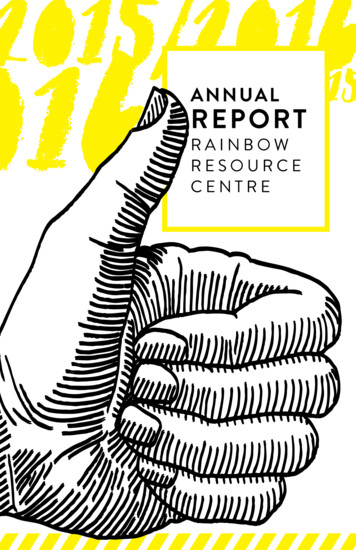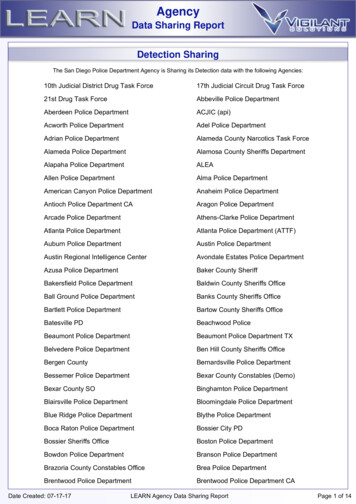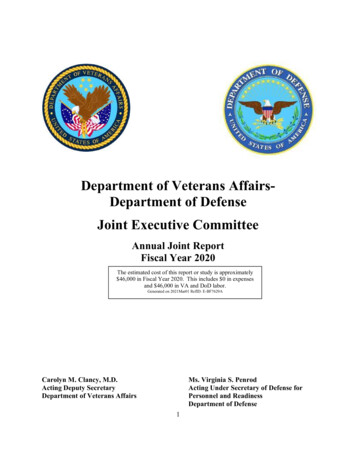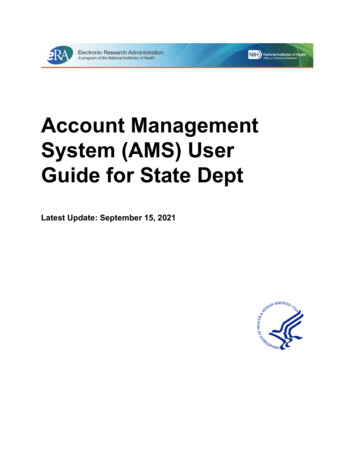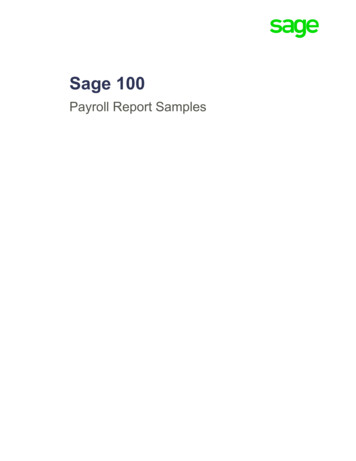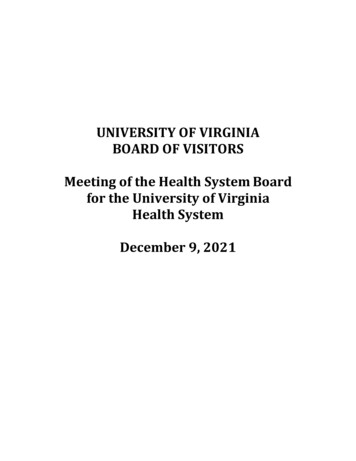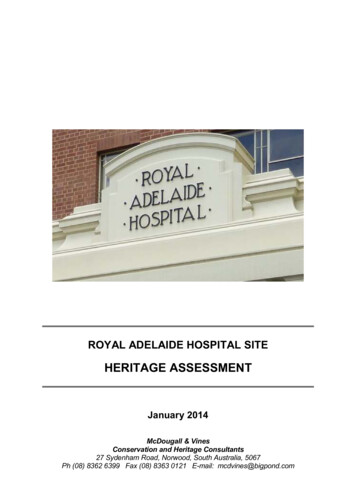
Transcription
ROYAL ADELAIDE HOSPITAL SITEHERITAGE ASSESSMENTJanuary 2014McDougall & VinesConservation and Heritage Consultants27 Sydenham Road, Norwood, South Australia, 5067Ph (08) 8362 6399 Fax (08) 8363 0121 E-mail: mcdvines@bigpond.com
Royal Adelaide Hospital Site Heritage AssessmentMcDougall & Vines, Conservation and Heritage Consultants, 27 Sydenham Road Norwood SA 5067
ROYAL ADELAIDE HOSPITAL SITE HERITAGE ASSESSMENTCONTENTSPage No.EXECUTIVE SUMMARY1.01.11.21.3INTRODUCTIONBackgroundStudy AreaObjectives of Study2.02.12.22.3OVERVIEW HISTORY OF ROYAL ADELAIDE HOSPITALIntroductionGovernment Involvement in Provision of Public HealthThe Site and Buildings of the Royal Adelaide Hospital2.3.1 Earlier Sites2.3.2 The Current Royal Adelaide Hospital Site2.3.3 The 1960s Building Program2.3.4 Later WorksLinks with Botanic Gardens and University of AdelaideAnalysis of Historic Themes2.5.1 Requirements of Brief2.5.2 Existing Frameworks of Historic Themes2.5.3 Consideration of National Themes2.5.4 Relevant Themes for Royal Adelaide Hospital Site2.42.53.03.13.23.33.44.04.14.24.33PHYSICAL ANALYSIS OF SITE AND BUILDINGSSite and ContextArchitectural Qualities of Site3.2.1 Stages of Development and Buildings3.2.2 The Owen Smyth/Lawson Architectural LegacyPrevious Assessments and Currently Listed Buildings3.3.1 Previous Assessments3.3.2 Currently Listed Buildings3.3.3 Additional Buildings to be AssessedAnalysis of Physical Development of Site39HERITAGE ASSESSMENT REPORTS: STATE HERITAGE PLACESIndividual Building Assessments Sheridan Building (former Kiosk) (1925) Bice Building (1927) Women’s Health Centre (1935) Allied Health Services Building (1935) IMVS Building (1938) McEwin Building (1945-46) Adelaide University Medical School (1947) Eleanor Harrald Building (1954) East Wing (1962) Adelaide Dental Hospital (1968) Residential Wing (including Chapel) (1969) The Sanctuary (2005)Summary of AssessmentsRelative Significance of Buildings59127186Royal Adelaide Hospital Site Heritage AssessmentMcDougall & Vines, Conservation and Heritage Consultants, 27 Sydenham Road Norwood SA 5067
ROYAL ADELAIDE HOSPITAL SITE HERITAGE ASSESSMENTCONTENTS (cont)Page No.5.05.15.2ASSESSMENT OF CITY OF ADELAIDE SIGNIFICANCESignificance of BuildingsSignificance of Visual AL ARCHAEOLOGICAL AREASIntroductionStatutory RequirementsMethodologyGathering InformationSite MappingAssessment of Archaeological PotentialArea of Exceptional Archaeological SignificanceRecommendations189APPENDICES1.0SOURCES OF INFORMATION AND BIBLIOGRAPHY2.0LIST OF EARLY PHOTOGRAPHS3.0BRIEF FOR SURVEY225STUDY TEAMMcDougall and VinesKatrina McDougallPatricia SumerlingLesley AbellAustralian Heritage ServicesCameron HartnellACKNOWLEDGMENTSMargot Way and Dr Peter Hetzel, Heritage Office, RAHMichael Frajer, Engineering and Building Services, RAHDr Julie Collins, South Australian Architecture Museum, UniSAStephen Forbes, Director, Adelaide Botanic GardensAndrew Cook, Archives Officer, University of AdelaideHarald Baulis, Property Services, University of AdelaideStaff and Archivists, State Records, Gepps CrossRoyal Adelaide Hospital Site Heritage AssessmentMcDougall & Vines, Conservation and Heritage Consultants, 27 Sydenham Road Norwood SA 5067
EXECUTIVE SUMMARYHistory of Hospital and Site - The hospital has existed on this site since 1855 and over timechanges have occurred with the upgrading of accommodation and new buildings. These haveoccurred in particular periods including the 1850s and 1860s, 1890s, 1920s and the 1960s.Medical development and population growth together were the impetus for these changes overtime.The earliest remaining building on the site is the Margaret Graham Nurses' Home which wasopened in 1910 and then the early 1920s Master Plan resulted in the four new buildings alongNorth Terrace. In 1951 a larger nurses' home, the Eleanor Harrald Nurses' Home wasconstructed. In the 1960s the East Wing was constructed to allow for demolition of all oldbuildings in the centre of the site which were replaced by buildings which are now currently inexistence.Along Frome Road the Institute of Medical and Veterinary Science (IMVS), the Dental Hospitaland the Adelaide University Medical School were constructed at different times to meet theexpanding health care requirements of South Australian population.Recommendations for Individual BuildingsFormer Margaret Graham Nurses’ Home (1911) (SHR) – retain as State Heritage ListedFormer Admission Casualty Building (Women’s Health Centre) (1935) (ACC) – elevate listingto State Heritage ListingSheridan Building (former Kiosk) (1925) - StateBice Building (1927) - StateAllied Health Services Building (1935) - StateIMVS Building (1938 1973) - No listingMcEwin Building (1945-6) - StateAdelaide University Medical School (1947) - StateEleanor Harrald Building (1954) - no listing?East Wing (1962) - No listingDental Hospital (1968 1921) - No listingResidential Wing (including Chapel) (1969) - No listingThe Sanctuary (2005) - No listingEarly Boundary Fencing - The 1850s sections of iron railing fence to North Terrace and the1920s and 1930s brick fencing to Frome Road should be retained, with heritage protection ifnecessary.Conservation Management Plans - All buildings on site which are provided with heritageprotection should be the subject of detailed Conservation Management Plans which will provideclear parameters for conservation, adaptation and redevelopment. The Conservation Plans willbenefit from the large amount of documentary and graphic material already located for eachbuilding.Additional Research - In conjunction with Conservation Management Plans to be prepared,additional research on the life of George Gavin Lawson and his works and sources of influencewould be a valuable project.Site Recommendations - Regardless of the protection provided by heritage listing, all usefulstructures and the context of the site should be retained in any new development whereverpossible.New Development Parameters - Although new development concepts have already beenprepared, it would be useful to refer to the heritage value and the information provided to informany approach to the redevelopment of these places and site, particularly the Lawson ‘suite ofbuildings’ along North Terrace.Royal Adelaide Hospital Site Heritage AssessmentMcDougall & Vines, Conservation and Heritage Consultants, 27 Sydenham Road Norwood SA 5067
Royal Adelaide Hospital Site Heritage AssessmentMcDougall & Vines, Conservation and Heritage Consultants, 27 Sydenham Road Norwood SA 5067
Page 11.0INTRODUCTION1.1BackgroundThe construction of a new hospital for Adelaide and South Australia has begun, and theproposed redevelopment of the current Royal Adelaide Hospital site is under consideration. TheSouth Australian Heritage Council received a nomination in March 2012 for the Royal AdelaideHospital (RAH) site to be designated a State Heritage Place.While the nomination is for the whole RAH site, it particularly identifies the following buildings onthe site for consideration: Adelaide University Medical School, Frome Road Dental Hospital, Frome Road Institute of Medical & Veterinary Science (IMVS) Building, Frome Road Eleanor Harrald Building, Frome Road Allied Health Services Building, North Terrace Sheridan Building (former Kiosk), North Terrace McEwin Building, North Terrace Bice Building, North Terrace East Wing, North Terrace Residential Wing (including Chapel) The Sanctuary (between the Theatre Block and Central Tower)The Margaret Graham Nurses' Home, located on Frome Road, is already entered in the SouthAustralian Heritage Register (SHR 13093) and the Women’s Health Centre (former Outpatientsand then Nursing School), on the corner of Frome Road and North Terrace, is designated as aLocal Heritage Place in the Adelaide City Council’s Development Plan.1.2Objectives of StudyAssessment of the heritage significance of the buildings/structures on the RAH site against thecriteria under the Heritage Places Act 1993 is required. This assessment process is to ensurethat only those components of the RAH site that are of State Heritage Significance areconsidered for entry in the South Australian Heritage Register as State Heritage Places.The primary objective of the Royal Adelaide Hospital Heritage Assessment is to provide anauthoritative description and evaluation of the heritage and potential archeological values of thesite. The brief encompasses an assessment of built structures and an investigation of potentialareas of archaeological significance informed by physical inspection of the site and historicalresearch.This heritage assessment of buildings on the RAH site does not include consideration of theIndigenous heritage values of the site as they do not fall under provisions of the Heritage PlacesAct 1993.Royal Adelaide Hospital Site Heritage AssessmentMcDougall & Vines, Conservation and Heritage Consultants, 27 Sydenham Road Norwood SA 5067
Page 21.3Study AreaThe study area encompasses the Royal Adelaide Hospital, IMVS, Dental Hospital and Universityof Adelaide Medical School South, as indicated on the following plan.NExtent of Study AreaRoyal Adelaide Hospital Site Heritage AssessmentMcDougall & Vines, Conservation and Heritage Consultants, 27 Sydenham Road Norwood SA 5067
Page 32.0OVERVIEW HISTORY OF ROYAL ADELAIDE HOSPITAL2.1IntroductionThe history of a hospital and its site will encompass significant aspects of the architectural,clinical and social developments of its context and location. All three elements combine to createthe hospital as an institution.The Royal Adelaide Hospital has occupied an important physical and emotional place in thehistory of South Australia. Located on a prominent corner of Colonel Light's plan for the city andparklands, it has been the focus of medical care, education and research since the 1850s andhas played an essential role as the centre of advances in health care and services since itsinception.When giving a presentation at the Royal Adelaide Hospital Foundation Addresses celebrating theRoyal Adelaide Hospital’s 150th anniversary in 1993, Peter Cahalan, then director of the HistoryTrust of South Australia, noted that ‘the hospital reflects a tradition of centralisation which wasestablished from the beginning here. Adelaide from the earliest days dominated the colony. AndAdelaide’s central institutions for [so] long had no serious rivals. The Royal Adelaide Hospitalhas been a nursery for the nurture of an entire hospital service spanning the State.’12.2Government Involvement in Provision of Public Health1836-1900The earliest medical experts and the services they provided from the first temporary hospital inAdelaide were always financially supported by the South Australian government. Thispartnership developed throughout South Australia from 1836 to the present day into abewildering network of services that comes under the umbrella of public health. The SouthAustralian government has been responsible for the health and welfare of its citizens sinceEuropean settlement in 1836. In fact the first colonial surgeon, Dr Thomas Young Cotter, wasappointed by the Colonisation Commissioners for SA in 1835 in England before the Province ofSouth Australia was officially proclaimed in December 1836.2The colonial government was mindful of supporting a healthy population, beginning whenassisted passages were granted to healthy single labourers or those married with wives andfamilies. Further, to nurture a potential workforce and to ensure migrants arrived in SouthAustralia healthy, surgeons were appointed to migrant ships to oversee their health on the longsea voyage. Even matrons were appointed to oversee the health and welfare of large numbersof single female migrants journeying on their own or within a large group. Despite the presenceof a surgeon throughout a voyage, good health could not be guaranteed and it was inevitablethat migrants arrived in South Australia with ongoing serious health issues such as tuberculosis,smallpox or other contagious diseases that needed immediate isolation from the rest of thepopulation. Intervention by the government was crucial after a ship arrived in 1838 with smallpoxon board and passengers were confined aboard the ship they had travelled on for there were nofacilities ashore.3As early as 1838 regulations for quarantine purposes was legislated through SA GovernmentOrder No 11 of 27 September. A year later in July 1839 the colonial surgeon was on hand toperform free vaccination for immigrants every Tuesday from 11 am to 12 at the temporaryhospital at Emigration Square, as well as attending to the indigenous people every Wednesdayat the Native Location.4 In 1849 a Health Officer was appointed at Port Adelaide to performrelevant duties ‘to prevent importation of pestilential or infectious diseases’. A year later in 1850there was further legislation by Ordnance No 3 1850 ‘To provide for the prevention of the spread1Peter Cahalan, ‘Hope, History and the Royal Adelaide Hospital’, in The True Glory – RAH Foundation Day Addresses1979-1993, p 110, editor Bernard Nicholson, 1993.2Ian LD Forbes, From Colonial Surgeon to Health Commission: The Government Provision of Health Services in SouthAustralia-1995, 1996, p1.3Ian LD Forbes, From Colonial Surgeon, p122.4Ian LD Forbes, From Colonial Surgeon, p125.Royal Adelaide Hospital Site Heritage AssessmentMcDougall & Vines, Conservation and Heritage Consultants, 27 Sydenham Road Norwood SA 5067
Page 4of Epidemic and Contagious Disease on the arrival of merchant Vessels’ which was gazetted inJune 1852.5 Vaccination services were extended from December 1853 when vaccination forchildren became compulsory under the Compulsory Vaccination Act, No 16. Infants born on andafter 1 January 1854 were vaccinated by qualified doctors within 4 months after birth or 6 monthsif they lived in isolated districts.6In 1850 the need to isolate contagious diseases from spreading through the population sawTorrens Island as a suitable place for a quarantine station, and in 1856 2000 was placed on theestimates. When nothing happened, with the issue of outbreaks of serious infectious caseswhen they needed to be isolated, this took place at the North Arm in tents. Then, in 1876 thehulk the ‘Fitzjames’ was bought for use as a quarantine station for serious cases for severalyears until the Torrens Island Quarantine Station was built in 1878. The island was controlled bythe colonial government until it became a federal responsibility from 1901.7 Several Acts followedin the 1880s and 1890s for the compulsory notification of all cases of infectious diseases.In 1878 the Da Costa and Yates Wards were built in a separate structure to the rear of the mainAdelaide hospital building as contagious diseases wards. By the early 1900s when thecontagious diseases wards could no longer accommodate the rising numbers of afflictedpatients, a new two storey building was constructed to the rear of the east wing of the main 1857hospital building in 1899.A year earlier in 1898 under a new Health Act, tuberculosis was proclaimed as a notifiabledisease. However, when the newly constructed building proved to be totally unsuitable, it wasclosed in 1901 and patients were transferred to the former Lunatic Asylum in Botanic Gardens in1906. It became known as the Infectious Diseases Block of the Adelaide Hospital with its ownBoard and Honorary Medical Officer.8 For the long term sufferers of infectious diseases such ascancer and tuberculosis, a SA Cancer and Consumptive Home was established in 1885, whilethe Kalyra Sanatorium at Belair was established as a home for consumptive and crippledchildren.9Apart from migrants arriving in South Australia with contagious diseases, some families arrivedimpoverished after a death of a father or husband on the voyage. Yet others arrived with mentalillnesses. Through many experiences of desperate need suffered by immigrants from 1837,government services were established, further developed and refined as the populationincreased. Government welfare and medical services were eventually provided throughsubstantial institutional buildings that were constructed through which vital services wereavailable. These included hospitals to cure the physical ills of the body, asylums to cure theafflictions of mental illness and a destitute asylum to accommodate the impoverished. A furtherarea was established for the local indigenous population who also needed the provision of vitalservices.Located on its present site since 1856 the Royal Adelaide Hospital grew in a haphazard waysince European settlement until the 1920s. For four years before 1841, medical assistance wasprovided by the first colonial surgeon Dr Thomas Young Cotter whose duties, as stressed byGovernor Hindmarsh, would be ‘exactly similar’ to those of a Parish Surgeon in England followinghis arrival in early 1837.10 From January 1838 he was given further instructions to attendgratuitously to all migrants and their families for three months after arrival, and anyone elsewhose circumstances required free attendance.11 After providing medical services from HindleyStreet, for 18 months, he moved his facilities to Emigration Square until the second colonialsurgeon took over in July 1839 and remained in the position for 20 years.When the government undertook to build a new hospital it recorded that part of the expense ofthe Infirmary would be defrayed by private subscriptions, but it was mindful that the largest5Ian LD Forbes, From Colonial Surgeon, p110.Ian LD Forbes, From Colonial Surgeon, p125.7Ian LD Forbes, From Colonial Surgeon, pp130-31.8It closed and became the Ophthalmic Building from 1902. Forbes, From Colonial Surgeon p149.9Ian LD Forbes From Colonial Surgeon, p142.10Ian LD Forbes, From Colonial Surgeon, p2.11Ian LD Forbes From Colonial Surgeon, p3.6Royal Adelaide Hospital Site Heritage AssessmentMcDougall & Vines, Conservation and Heritage Consultants, 27 Sydenham Road Norwood SA 5067
Page 5portion ‘must be contributed by the Government’.12 Although it was hoped that the public woulddonate at least a third of the costs the reality was that the economy was in such dire straits thatany hoped-for generosity was not forthcoming and the government was burdened by the debt.And from the date of its completion, hospitals were financed almost entirely from the SAGovernment until the Commonwealth Government took over in 19?.On 9 February 1841, just before the hospital was opened to receive patients, a board ofmanagement was established consisting of government officials with medical control firmly in thehands of the Colonial Surgeon. The Southern Australian published an advertisement forapplications from medical gentlemen, legally qualified to practice to become honorary medicalofficers of the hospital. The Board of the hospital comprised 12 gentlemen appointed by theGovernor, with six of them being permanent government officers and six gentlemen beingelected annually.13 The hospital followed in a welfare tradition established in England with‘admissions of paupers, accident cases and seamen’ as well as fee paying patients.14Then in 1844 there was legislation for ‘an ordinance to make provision for the safe custody of,and prevention of offences by, persons dangerously Insane, and for the care and maintenance ofpersons of unsound mind’15 At first, power was delegated to five official visitors nominated by theGovernor to oversee this legislation in having the insane rounded up and incarcerated intoAdelaide Gaol until certified to be of sound mind.16 While in Gaol, the mentally ill were treated ashospital patients with a special hospital diet and not that of prisoners. However, the environmentof the Gaol made it very difficult to administer the mentally ill and by 1845 when the numberswere increasing, they needed their own turnkey.17In the 1840s there was an early attempt to establish a mental asylum at Parkside, where theformer Glenside Hospital is now situated. In 1847 when the duties of the colonial surgeon wereexpanded to become the Superintendent of the Colonial Lunatic Asylum, the logistics of itslocation saw a decision to build a lunatic asylum next to the 1841 Adelaide Hospital in what isnow the Botanic Gardens, situated off North Terrace in 1852. When this asylum becameovercrowded a new one was built as the Parkside Mental Hospital (called Glenside in 1967) thatwas opened 18 May 1870.18 Earlier in 1869 10 health or medical officers cared for the sick anddestitute at direction of local councils, under authority of the Crown Lands and ImmigrationOffice.19In the 1850s the Colonial Surgeon’s duties expanded: he was attending meetings of the MedicalBoard, the Central Vaccine Board and the Destitute Board, attending to the good health of theinmates at Yatala Gaol at Dry Creek, overseeing the work of a new hospital at Kooringa nearBurra and also the Female Immigrant depot. The provision of medical services provided throughthe Adelaide Hospital wavered between control by the Colonial Surgeon and control by a Boardof Management20. While the Hospital Board held control of the management of the hospital, theoverriding factor was that the government bore the financial burden of supplying services andpaying the cost of building works when requested or needed - then it was a governmentinstitution.21In the 1860s, the hospital was still using the rules and regulations of a British charity hospital.This meant patients unable to pay for the cost of their treatment undertook chores as directed bythe nurses while they recuperated.22 Following an 1866 Select Inquiry that investigated theworking and management of the hospital, legislation led to the appointment of a Board of12Ian LD Forbes From Colonial Surgeon, p27.Ian LD Forbes From Colonial Surgeon pvii14Ian LD Forbes, From Colonial Surgeon, p vii.15Ordinance No 10 of 1844 in Ian LD Forbes, From Colonial Surgeon p65.16Ian LD Forbes, From Colonial Surgeon, p 66.17Ian LD Forbes From Colonial Surgeon, p 66.18Ian LD Forbes From Colonial Surgeon, pp 21, 91, 281.19Ian LD Forbes From Colonial Surgeon, p342.20J Estcourt Hughes A History of the Adelaide Hospital,1982, Chapter 6(passim)21Ian LD Forbes From Colonial Surgeon, p31.22Ian LD Forbes From Colonial Surgeon, p98.13Royal Adelaide Hospital Site Heritage AssessmentMcDougall & Vines, Conservation and Heritage Consultants, 27 Sydenham Road Norwood SA 5067
Page 6Management of eight medical and three non-medical lay members.23 This saw a reversal ofroles where the honorary staff were in charge of managing the hospital and paid any medicalstaff under their direction. They also took over full control of the hospital from the ColonialSurgeon, which meant it was no longer under government control, although still financed byannual parliamentary grants. And then in January 1868 the Adelaide Hospital was proclaimed apublic hospital through the SA Government Gazette, and from 1870 the board published its ownrecords.24It was almost 30 years after the British 1848 Public Health Act that legislation for a similar Act inSouth Australia was gazetted in 1873. Until then, the general population endured poorsanitation, no rubbish collections, the effects of noxious trades, polluting factories and dwellingsunfit for habitation.25 Following the establishment of a Sanitation Commission in 1874 toundertake such challenges as deep drainage, the Adelaide City Council began installing such asystem throughout the city. To the Council's great credit, this was completed by 1885.Completion of the deep drainage system led to the building of a 190.2 hectare (470 acre)Sewage Farm at Islington.26 However, the installation of deep drainage exposed many of theexisting facilities at the Adelaide Hospital as being poor, including lack of running water whereneeded.Emeritus Professor Roger Angove, when giving a presentation about tuberculosis control in thestate, quoted Sir Joseph Verco, an honorary physician who wrote of the hospital before the1880s that there was no specialisation. Verco noted that ‘medical and surgical cases of all kindswere placed in the same ward without discrimination except males and females were in differentrooms. Broken bones, pneumonia, wounds and bruises and putrefying sores, typhoid, hipdiseases, bad eyes and everything else as they happened to come in were put into a bed whichchanced to be vacant and the GP went from one to the other.27 From the 1880s there weremoves towards the establishment of specialties beside medicine and surgery. Before 1900 therewere specialisation in ophthalmics, pathology, gynaecology, diseases of ear, nose and throat anddermatology.28 In the early twentieth century departments were established for radiology in 1908and clinics for orthopaedics in 1935 and urology in 1950.Post 1900By 1910 the Adelaide Hospital’s bacteriological laboratories had become too small within the1899 isolation wards for infectious diseases and new laboratories were built. When these wereoccupied in 1913, a government decision saw the centralisation of bacteriological andpathological work for the whole state. This allowed other organisations to use the laboratoriessuch as the Commonwealth Quarantine Department, Central Board of Health and the VeterinaryDepartment, an arrangement which was considered unique in Australia. Called ‘the Laboratory’,the facility was placed under direction of the Board of Management of the Adelaide Hospital.When the Adelaide University Medical School was celebrating its first 50 years, new laboratoriesknown at first as the Institute of Medical Science (IMVS) were considered for use in the trainingof medical students. When it was completed years later, it became known as the Institute ofMedical and Veterinary Science, coming into effect in June 1938. A month later the existing SAGovernment Laboratory of Pathology and Bacteriology, ‘the Laboratory’, became part of theIMVS.Dentistry in South Australia took on importance following the Dental Act of 1902 through which adental board made regulations and three years later it turned its attention to dental education.Training to become a dentist took a minimum of 4 years with apprenticeship to a registereddentist. University courses began in 1906 with the first students graduating in 1911. Throughthe planning of the University of Adelaide, the Adelaide Hospital Board of Management andthrough the Superintendent of Public Works, C E Owen Smyth, plans for a dental school and23Act No 7 of 1867. It also entailed that the medical officers took over duties of the colonial surgeon to undertake hisduties at the gaol, the Destitute Asylum and other institutes for the destitute poor. Forbes, From Colonial Surgeon, pp99-103.24RAH Heritage Office, The History of Adelaide Hospital 1840-1990, p2.25Ian LD Forbes, From Colonial Surgeon, pp 131-35.26Ian LD Forbes, From Colonial Surgeon, p vii.27Roger Clare Angove, ‘Tuberculosis control in SA’ in The True Glory – RAH Foundation Day Addresses 1979-1993, p115, editor Bernard Nicholson, 1993.28Ian LD Forbes, From Colonial Surgeon, p107.Royal Adelaide Hospital Site Heritage AssessmentMcDougall & Vines, Conservation and Heritage Consultants, 27 Sydenham Road Norwood SA 5067
Page 7hospital were drawn up in 1919. The functions of the dental hospital included treatment of thepoor, sailors and soldiers and their dependents, and patients unable to afford privatepractitioners were means tested. The hospital/school also provided students with clinicalfacilities. The construction of the hospital/school, opened in July 1923, was made possiblethrough a substantial monetary gift from the British Red Cross, with additional funding from theSA government.29 In this period the government dentist was responsible for the dental care ofinmates at gaols, mental hospitals and the State Children’s Department.30Following the Second World War in 1948 a building committee drew up plans for theenlargement of the 1920s dental hospital building. It was not until 1958 that construction gotunderway and two wings were added. However, the facilities were still inadequate and a newbuilding was built and opened in August 1969. The Health Commission amalgamated the Schoolof Dental Service and the Dental Hospital in June 1982 to become known as the SA DentalService.311920-40Two years before the Hospital Amendment Act in 1921 in which the Department of Health wasestablished, South Australia suffered the devastation caused by the loss of lives through theworld-wide influenza epidemic from 1918. There was a total loss of about 10,000 livesthroughout Australia. When South Australia’s existing facilities were unable to cope, emergencyarrangements were made and those afflicted by the deadly disease were confined to temporaryisolation wards created at the Exhibition Hall on North Terrace.The influenza epidemic was a wake-up call to public health authorities, mindful that anestablishment needed be constructed for the purpose of isolating hundreds in future epidemicsand persons afflicted by contagious diseases. The Board of Management of the AdelaideHospital reported to the Premier that a modern infectious diseases hospital should be providedand an Act to this effect was formulated in 1922 - but it was not passed until 1929. Although anearlier Health Act of 1898 had made local boards of health responsible for providing facilities intheir districts, none had ever done so, preferring to depend on what facilities the AdelaideHospital could provide. More than 20 years later a purpose-built one was established atNorthfield as the Infectious Diseases Hospital and opened October 1932.32 When it opened, theearlier Contagious Diseases Hospital established in 1906 within the former North Terrace LunaticAsylum on the site of the present Botanic Gardens was closed. The new institution was run by aboard made up from members of local boards of health and w
2.3.3 The 1960s Building Program 2.3.4 Later Works 2.4 Links with Botanic Gardens and University of Adelaide 2.5 Analysis of Historic Themes 2.5.1 Requirements of Brief 2.5.2 Existing Frameworks of Historic Themes 2.5.3 Consideration of National Themes 2.5.4 Relevant Themes for Royal Adelaide Hospital Site
